“PLANT-SOIL INTERACTIONS” – Scientific Achievements – Research Group 1n
Research Group
Genetic resources, nutrient use efficiency and stress tolerance in cereals
A prerequisite for sustainable crop production is the science-based development of cultivars with improved agronomic performance and adaptability to changing environment. Current research of the group is aimed towards the evaluation of genetic variability and understanding the genetics and physiological mechanisms that control traits of beneficial impact on plant productivity (nitrogen use efficiency) and stress tolerance (with emphasis on osmotic stress). The research is focused on cereals (wheat and barley). We integrate genetic approach with physiological, biochemical, biophysical and cytological methods. The main objective is translational research that could bridge the gap between fundamental research and practical crop breeding by moving the experimentation from laboratory to field. This could aid breeders to implement the acquired knowledge into innovative developments.
The plants regulate their growth in accordance with the availability of basic resources, mainly water and nutrients. Knowledge of how plants respond to shortages of these resources is important to identify appropriate approaches to improve their efficiency and maintain productivity in areas with limited water and food resources. Among the important factors related to the drought response in wheat are the processes of uptake and assimilation of inorganic nitrogen from the soil and absorption of light energy and carbon from CO2 in the process of photosynthesis. Clarifying the relationship between nitrogen and photosynthetic exchange during drought of different wheat genotypes is essential for building the image of a drought tolerant plant.
(2016-2021) A bilateral joint research project between Institute of Plant Physiology and Genetics – BAS and Slovak University of Agriculture in Nitra, Faculty of Agrobiology and Food Resources, Nitra, Slovakia, entitled “Evaluation of plant response to drought stress and N deficiency based on the investigation of the relationship between photosynthesis and nitrogen metabolism of Bulgarian and Slovak bread wheat varieties”, Project leader: Prof. Dr. S. Misheva, members: Assoc. Prof Dr. K. Kocheva, Assist. Prof. Dr. P. Petrov, Assist. Prof. Dr. T. Karceva
The plants regulate their growth in accordance with the availability of basic resources, mainly water and nutrients. Knowledge of how plants respond to shortages of these resources is important to identify appropriate approaches to improve their efficiency and maintain productivity in areas with limited water and food resources. Among the important factors related to the drought response in wheat are the processes of uptake and assimilation of inorganic nitrogen from the soil and absorption of light energy and carbon from CO2 in the process of photosynthesis. Clarifying the relationship between nitrogen and photosynthetic exchange during drought of different wheat genotypes is essential for building the image of a drought tolerant plant.
It was found that the varieties of common wheat Enola (modern, carrier of low-stem genes) and Slomer (ancient, high-stemmed), differing in their nitrogen efficiency in field conditions, differ significantly in their photosynthetic capacity, enzymatic activities and content of osmolytes. in response to nitrogen nutrition in the early stages of plant development. The effects of reduced nitrogen nutrition have been shown to be related to carbon metabolism (Figs. 1, 2). The ancient local variety Slomer has better photosynthetic capacity and better nitrogen assimilation, as evidenced by the increased synthesis of amino acids and better growth in conditions of induced nitrogen deficiency. The modern variety Enola is characterized by preferential accumulation of sugars with reduced nitrogen supply in the environment.
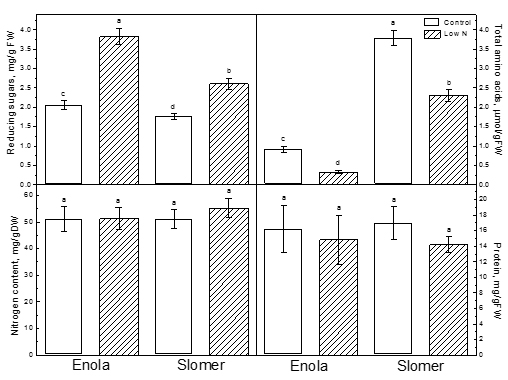
Fig. 1. Content of soluble sugars, amino acids, nitrogen, and soluble protein in case of nitrogen deficiency in the nutrient solution (low N) and in the control plants in two varieties of wheat.
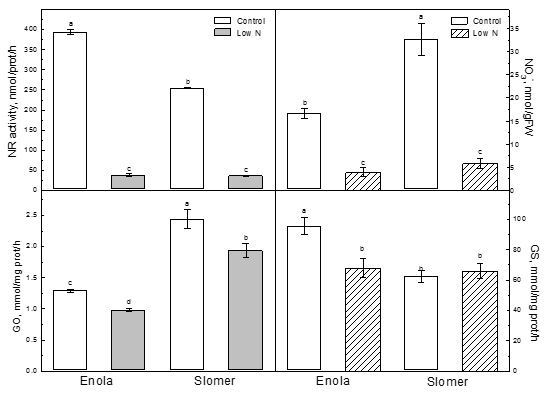
Fig. 2. Activity of nitrate reductase (NR), glycolate oxidase (GOX), and glutamine synthetase (GS) activity, and nitrate content, in the leaves during nitrogen deficiency in the nutrient solution (low N) and in controls in two wheat varieties.
It was found that the modern low-stem variety Enola retains better photosynthetic capacity (Fig. 3) with a simultaneous deficiency of basic resources, water and nitrogen, compared to the ancient variety Slomer, despite the higher degree of oxidative stress and cell-membrane injuries recorded with Enola (Fig. 4, 5).
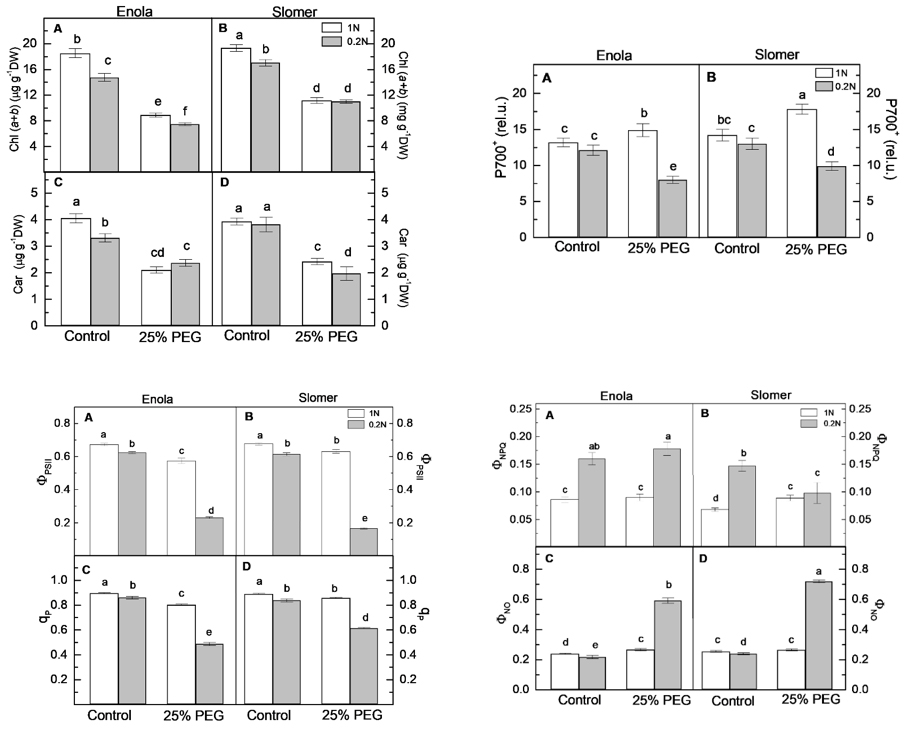
Fig. 3. Changes in pigment content and photosynthetic capacity in the leaves of two wheat varieties grown at optimal (1N) and reduced (0.2N) nitrogen supply and subjected to osmotic stress with 25% PEG.
We assume that differences in genetic background lead to different strategies to overcome osmotic stress alone or accompanied by nitrogen deficiency and that the presence of low stem genes (Rht genes) in modern wheat varieties is likely to have a beneficial effect in areas with a shortage of basic resources – water and nitrogen.
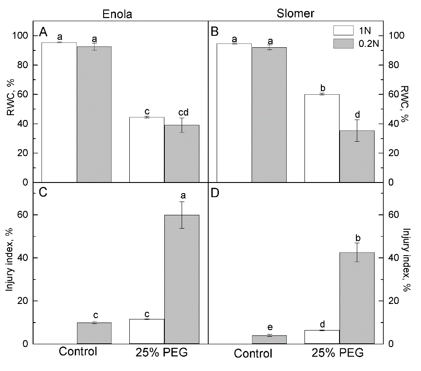
Fig. 4. Changes in relative water content (RWC) and cell membrane damage index in the leaves of two wheat varieties grown at optimal (1N) and reduced (0.2N) nitrogen supply and subjected to osmotic stress with 25% PEG.
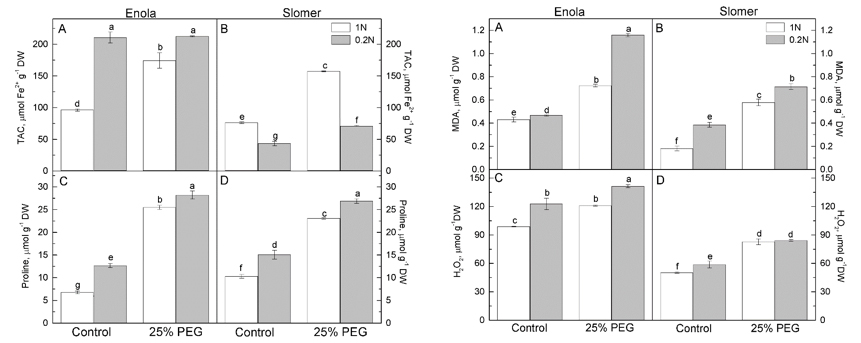
Fig. 5. Markers for oxidative stress and accumulation of proline in the leaves of two varieties of wheat grown at optimal (1N) and reduced (0.2N) nitrogen supply and subjected to osmotic stress with 25% PEG.
A relationship has been established between leaf morpho-anatomy, water status and the stability of cell membranes in wheat leaves at severe soil drought. It was found that modern low-stem varieties carrying Rht genes are characterized by smaller leaf area, smaller leaf perimeter, lower values of leaf dissection index (DI) – a parameter that characterizes the shape of the leaf. (have a more rounded shape), while the ancient tall stem varieties have higher DI values (more elongated leaf shape). It has been found that in modern varieties carrying low stem genes, the more rounded shape of the leaves helps to better maintain water balance and membrane integrity in the leaves under water-deficient stress. A model was also created proving the importance of the shape of the evaporating surface for the amount of evaporated water (Fig. 6). The results of this task show the effect of the leaf form on transpiration and contribute to the elucidation of the mechanisms by which plants maintain their water reserves during periods of drought.
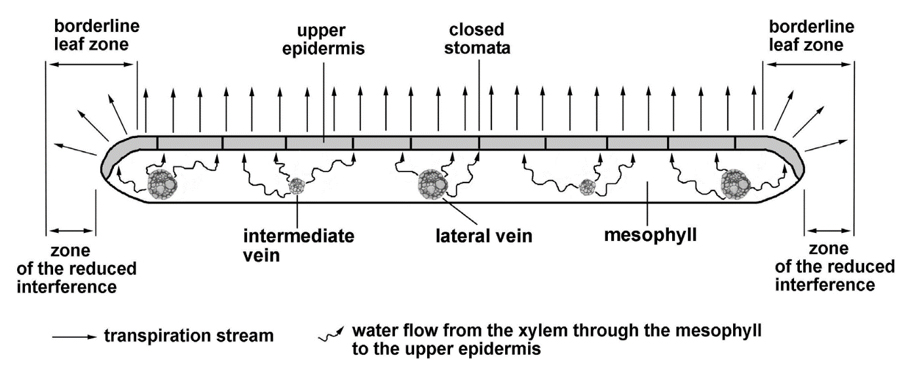
Fig. 6. Schematic representation of the transpiration from the upper leaf epidermis with closed stomata.
Project KP-06 N31/17, supported by the Bulgarian NSF for the period (2019-2022). Principal investigator: prof. Svetlana Misheva. Participants: associate prof. Konstantina Kocheva, assistant prof. Tania Kartseva
Project title: Genome wide association study of grain yield, grain protein content and grain nitrogen concentration in Bulgarian bread wheat germplasm
The project is in accordance with the European and global efforts for improvement and sustainability of crop productivity to meet the increasing demands for feeding the growing human population. The project also complies with the global efforts to characterize, evaluate, preserve and effectively utilize the plant genetic resources.
Main aims: 1) characterization of the molecular genetic structure of the Bulgarian bread wheat population; 2) estimation of the genetic variability for grain yield and grain quality related traits (yield components and grain protein content); 3) deciphering the genetic architecture of these traits and identification of the responsible genomic regions by applying a linkage disequilibrium-based association mapping approach.
Achieved results:
We described SNP-based genetic diversity, linkage disequilibrium and population structure in a panel of 179 bread wheat advanced cultivars and old accessions from Bulgaria, using an optimized wheat 25K Infinium iSelect array. Out of 19,019 identified polymorphic SNPs, 17,968 had а known chromosome position on the A (41%), B (42%) and D (11%) genome, and 6% were not assigned to any chromosome (Fig. 1). Homoeologous group 4, in particular chromosome 4D, was the least polymorphic. Significant differences between the old and modern collections were revealed with respect to the Nei’s gene diversity, Polymorphism Information Content (PIC), and linkage disequilibrium (LD). Structure and k-mean clustering algorithm divided the panel into three groups – two subpopulations, consisting mainly of modern releases and one distinct subpopulation, including predominantly old accessions (Fig. 2). Gene exchange was evidenced mainly between the subpopulations of modern cultivars. The achieved understanding of the genetic diversity and structure of the Bulgarian wheat population and distinctiveness of the old germplasm could be of interest for breeders developing cultivars with improved characteristics using the unrealized potential of the old genepool. The obtained knowledge about SNP informativeness and the LD estimation are worthwhile for selecting markers and for considering the composition of a population in association mapping studies of agronomic traits as it is planned in the current project.

Fig. 1. Distribution (A) and density (B) of SNP markers along the wheat chromosomes within a population of 179 old and modern Bulgarian bread wheat accessions.
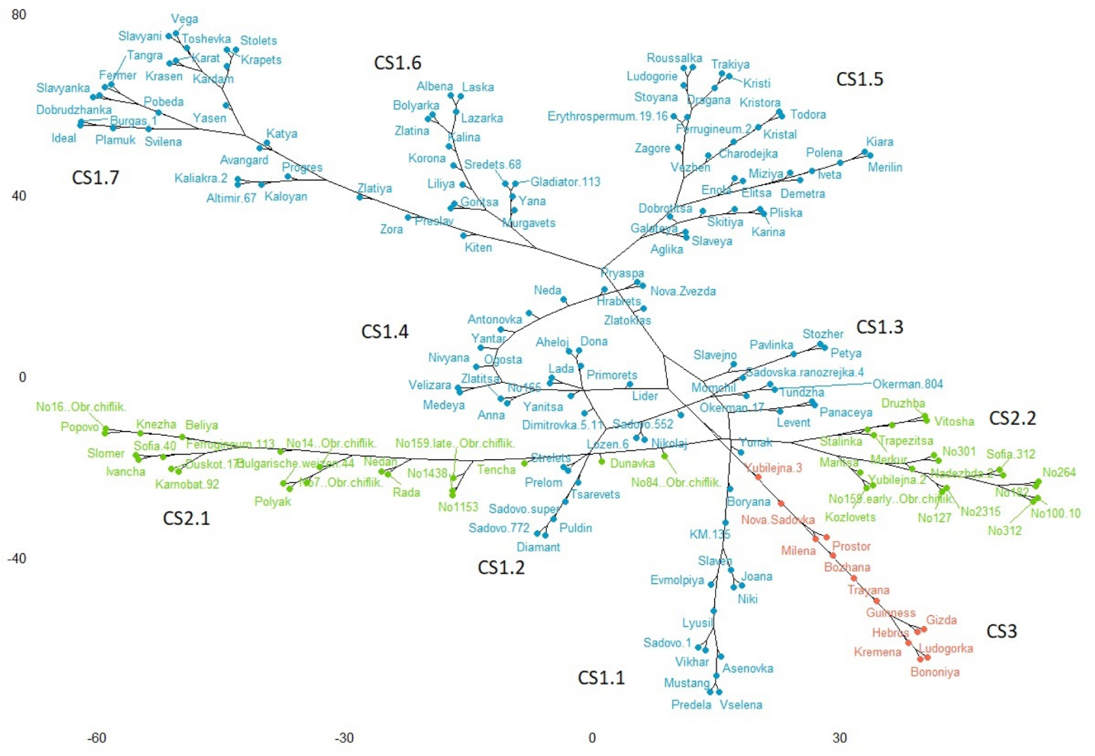
Fig. 2. A neighbor-joining dendrogram inferred by the K-mean clustering algorithm distributed the Bulgarian bread wheat cultivars into three clusters: CS1 and CS3, consisting of mainly modern cultivars, and CS2, consisting predominantly of old accessions.
